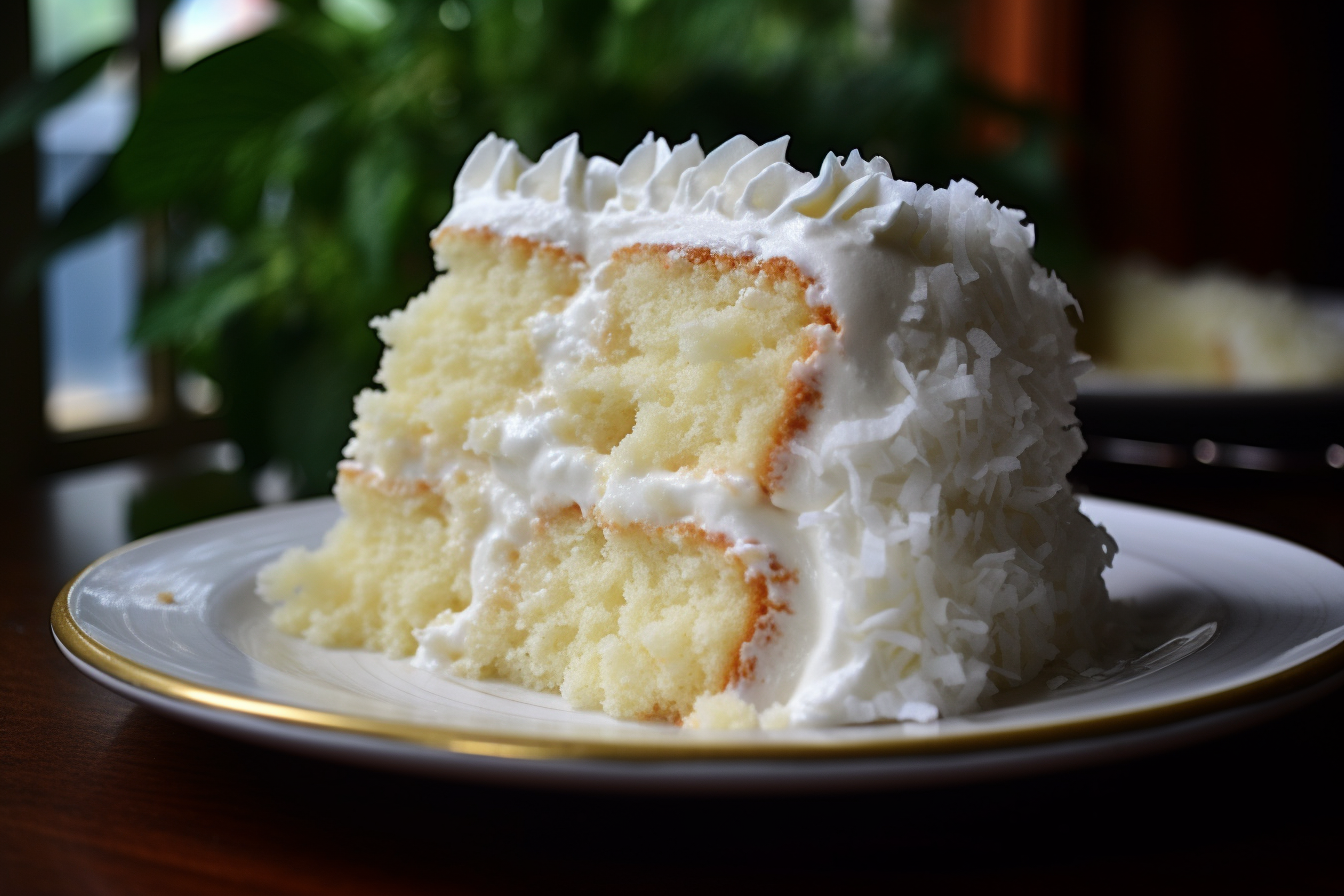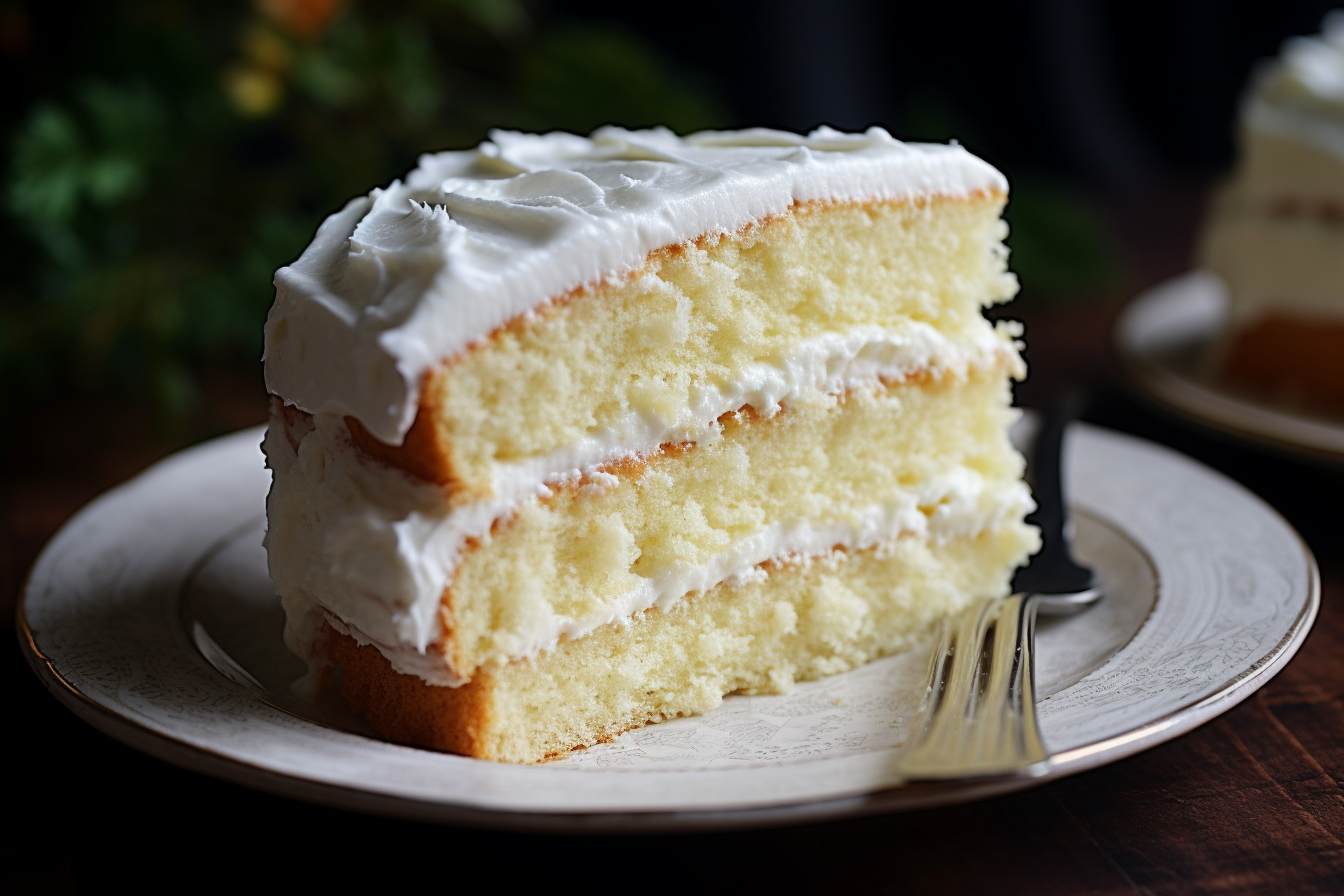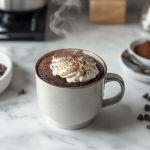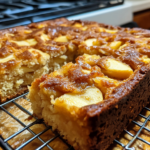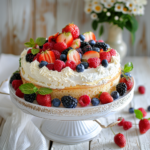Enter the world of confectionary brilliance with this stunning White Cake that promises to transform your dessert experience. Set out on a delicious adventure where each piece is a work of baking art. This white cake, which combines the best ingredients to produce a symphony of tastes that will captivate your taste buds, is a masterwork of simplicity and finesse.
A delightful balance of sweetness and lightness forms the basis of this gourmet creation, making every bite an indulgent feast. The flawless marriage of silky textures and delicate undertones is a testament to the baker’s meticulous attention to detail. This white cake invites you to indulge in a sensory experience that goes beyond the typical, from the moment you first see it and until the very last crumb ends up on your plate.
Take pleasure in the attention to detail that went into creating this dessert masterpiece, which combines superb ingredients in a culinary dance of elegance. The delicate tastes that emerge with each mouthful are showcased by the white cake’s simplicity. As you indulge in a symphony of sweetness that takes the traditional white cake to new heights of culinary elegance, get ready to be enthralled.
What is White Cake?
White cake is a classic dessert known for its light and fluffy texture and sweet, vanilla flavor. Its pale color comes from using refined ingredients like white sugar and egg whites.
The recipe typically includes flour, baking powder, sugar, butter or shortening, milk, and vanilla extract. The cake is versatile, often paired with various frostings for celebrations like weddings and birthdays.
The result is a delicious, simple treat with a tender crumb that can be customized with different flavors and fillings.
White Cake V/S Vanilla Cake
Many people confuse white cake recipes with vanilla cake. Although similar, these actually are totally different types of cakes. Here’s the difference between the two:
| Feature | White Cake | Vanilla Cake |
|---|---|---|
| Color | Pale white | Can vary from light beige to pale yellow |
| Flavor | Primarily vanilla | Intensely vanilla, may have a richer flavor |
| Ingredients | Uses white sugar and often only egg whites | Includes whole eggs, may use a combination of white and brown sugar |
| Texture | Light and fluffy | Can range from light to dense, depending on the recipe |
| Versatility | Commonly used as a base for various frostings | Adaptable to different flavor variations, such as chocolate, citrus, or fruit-infused |
| Occasions | Popular for weddings and formal occasions | Widely used for various celebrations, including birthdays and casual gatherings |
| Appearance | Elegant and pristine | May have a slightly warmer hue due to the use of whole eggs |
| Customization | Easily customized with different extracts or flavors | Offers more flexibility in flavor variations due to the inclusion of whole eggs |
| Popular Pairings | Often paired with classic vanilla or buttercream frosting | Pairs well with a variety of frostings, including chocolate, cream cheese, or fruit-flavored options |
| Overall Characteristic | Light, delicate, and refined | Versatile, with a broader range of flavor and texture possibilities |
Tips for Perfect Egg Beating
Achieving perfect beating in baking is crucial for creating light, fluffy textures in your recipes. Here are ten tips to ensure your beating process is spot-on:
- Room Temperature Ingredients: Ensure that ingredients like butter, eggs, and dairy are at room temperature. This promotes better incorporation and a smoother batter.
- Use the Right Equipment: Use electric beaters, a stand mixer, or a hand mixer with appropriate attachments for the task. These tools provide consistent and efficient beating.
- Start Slow: Begin beating at a low speed to prevent ingredients from splattering. Gradually increase the speed as the ingredients incorporate.
- Cream Butter and Sugar Well: When creaming butter and sugar, beat them together until the mixture is light and fluffy. This creates air pockets that contribute to a soft texture.
- Scrape the Bowl: Periodically stop the mixer and scrape down the sides and bottom of the bowl to ensure even mixing. This helps incorporate any unmixed ingredients.
- Be Mindful of Overbeating: Overmixing can lead to a tough texture in baked goods. Stop beating as soon as the ingredients are combined and the batter is smooth.
- Alternate Wet and Dry Ingredients: When adding dry ingredients to wet, do so in batches, alternating with wet ingredients. This prevents clumps and ensures even mixing.
- Egg Addition: Add eggs one at a time, beating well after each addition. This allows for proper emulsification and a more uniform batter.
- Use the Right Technique: Pay attention to the recipe instructions. Techniques like folding or gently stirring may be required for specific batters.
- Consistency is Key: Ensure consistency in beating time for uniform results. Use a timer if needed, especially when creaming butter and sugar.
PRO TIP: The beating process can vary depending on the recipe, so always follow specific instructions for the best results in your baked goods.
Best White Cake Recipe
Equipment
- Electric Mixer or Hand Mixer
- Measuring Spoons and Cups
- Spatula
- Cake Pans
- Oven and Oven Mitts
- Cooling Rack
- Cake Stand
- Offset Spatula
Ingredients
For the White Cake:
- 1 cup unsalted butter softened
- 2 cups granulated sugar
- 4 large egg whites
- 1 tablespoon pure vanilla extract
- 3 cups all-purpose flour
- 4 teaspoons baking powder
- ½ teaspoon salt
- 1 ½ cups whole milk
For the Vanilla Buttercream Frosting:
- 1 cup unsalted butter softened
- 4 cups powdered sugar
- 1/4 cup whole milk
- 2 teaspoons pure vanilla extract
Instructions
For the White Cake:
- Preheat the oven to 350°F (175°C). Grease and flour two 9-inch round cake pans.
- In a large bowl, cream together the butter and sugar until light and fluffy. Add the egg whites one at a time, beating well after each addition. Stir in the vanilla extract.
- In a separate bowl, whisk together the flour, baking powder, and salt.
- Gradually add the dry ingredients to the wet ingredients, alternating with the milk, beginning and ending with the dry ingredients. Mix until just combined.
- Divide the batter evenly between the prepared pans and smooth the tops. Bake for 25-30 minutes or until a toothpick inserted into the center comes out clean.
- Allow the cakes to cool in the pans for 10 minutes before transferring them to a wire rack to cool completely.
For the Vanilla Buttercream Frosting:
- In a large bowl, beat the softened butter until creamy.
- Gradually add the powdered sugar, one cup at a time, beating well after each addition.
- Add the milk and vanilla extract, and continue to beat until smooth and fluffy.
- Once the cakes are completely cooled, frost the top of one cake layer, place the second layer on top, and frost the top and sides of the entire cake.
- Decorate as desired, and enjoy your classic white cake with vanilla buttercream frosting!
Notes
- Room Temperature Ingredients: Ensure butter, eggs, and milk are at room temperature for optimal blending and a smoother batter.
- Precision in Mixing: Cream butter and sugar until light, and avoid overmixing to maintain a tender and fluffy texture.
- Patient Cooling Before Frosting: Allow cakes to cool completely before applying frosting to prevent melting and achieve a polished finish.
Nutrition
NUTRITIONAL FACTS (PER SERVING)
| Nutrient | Amount per Serving |
|---|---|
| Calories | Approximately 250 |
| Total Fat | 12g |
| – Saturated Fat | 7g |
| Cholesterol | 40mg |
| Sodium | 200mg |
| Total Carbohydrates | 32g |
| – Dietary Fiber | 0.5g |
| – Sugars | 18g |
| Protein | 3g |
Secrets of Baking the Perfect, Pure White Cake!
- Room Temperature Ingredients: Bring butter, eggs, and dairy to room temperature for smoother incorporation and better texture in the final cake.
- Precise Measurement: Use accurate measuring cups and spoons for precise amounts of ingredients, especially when it comes to flour and leavening agents.
- Creaming Method: Cream butter and sugar thoroughly to incorporate air, ensuring a light and fluffy texture in the finished cake.
- Gentle Mixing: Mix dry and wet ingredients just until combined to avoid overmixing, which can lead to a dense or tough cake.
- Quality Ingredients: Use high-quality ingredients for enhanced flavor and texture. Fresh eggs, pure vanilla extract, and good-quality flour can make a significant difference.
- Oven Calibration: Ensure your oven is properly calibrated to the correct temperature. Invest in an oven thermometer to verify the accuracy.
- Proper Pan Preparation: Grease and flour cake pans adequately, or use parchment paper to prevent sticking and ensure easy removal.
- Even Batter Distribution: Level the cake batter in the pans to ensure even baking and uniform layers.
- Avoid Overcrowding: Bake multiple layers or cupcakes in separate batches to ensure even heat distribution and consistent baking.
- Patience in Cooling: Allow the cake to cool completely before frosting to prevent melting and maintain the integrity of the frosting.
Remember that practice makes perfect, so don’t be discouraged if your first attempt isn’t flawless. Each baking experience is a learning opportunity to refine your skills. For additional tips, read our Red Velvet Cake recipe and enhance your baking experience.

